Vinland Blog Archives 2019
Introduction
I have always been interested in the Vikings, especially their visits to North America and the encounters with the natives (Skraelings). As if to spur this on, I was commissioned to build a model of a Viking Longship for our Local Scandinavian Cultural Center. Near the same time I obtained a copy of the book Westviking by Farley Mowat (1965) and after reading it, Peg and I decided to take a vacation to Newfoundland where we would visit L Anse Aux Meadows, the only verified Norse site in North America. What we found there and the subsequent results of my research is remarkable.
Archive 2011-2017
Archive 2018
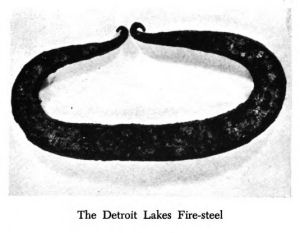
|
| Detroit Lakes Firestriker (Photo- Holand |
January 15
Pelican Lake, Minnesota
Mooring stone Holand #6
Geographical location: 46.701,-96.055
******
Ten Mile Lake, Tumuli Township, Minnesota
Mooring stone Holand #7
3" deep. Incomplete
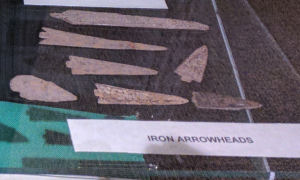
|
| Iron Arrow Points (Runestone Museum) |
Geographical location: 46.127,-95.970
******
Detroit Lakes, MN
Metal arrowheads
Firestriker
These items were found by archaeologist Otto Zeck in an area not yet settled. The current location of this firestriker is unknown. It is of proper Norse style.
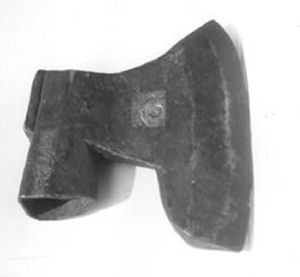
|
| Erdahl Axe (photo: Holand) |
Geographical location: 46.807,-95.924
February 15
Erdahl, Minnesota
Axe 1894
This axe was found by Julius Davidson. It was pulled up while uprooting tree stumps. The stumps were an average 2' in diameter. The axe was buried 1 and 1/2 feet in the ground. Davidson loaned the axe to Holand who identified it as identical to the St. Olaf Axe that is dated 1468. Note what appears to be a royal stamp
in the photograph. The current location is unknown.
Geographical location: 45.991,-95.826
******
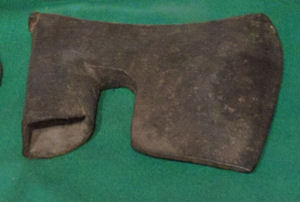
|
| Milan Axe (Runestone Museum) |
Axe 1930's
Found by Elmer Roen of Chokio, MN. This axe was reported by Anderson in 1994.
Geographical location: 45.112,-95.922
March 15
Ashby, Minnesota
Human Remains
Apparently there is a Swedish archaeological team doing a dig. Documentary cameras are reported to be present. This could be interesting.
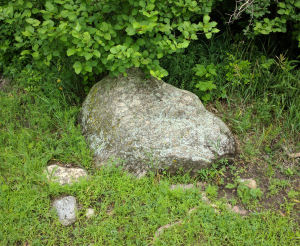
|
| Mooring stone on Skrall Hill |
******
Skrall Hill, Minnesota
Mooring Stone
Skrall Hill is immediately south of the KRS (Kensington Runestone) site and is part of the Runestone Park. A path from the road to the runestone site leads to a mooring stone. The path is a good work out. According to local residents there are supposed to be 3 stones on this hill.
Geographical location: 45.811, -95.666
April 15
Kensington, Minnesota
The Kensington Runestone 1898
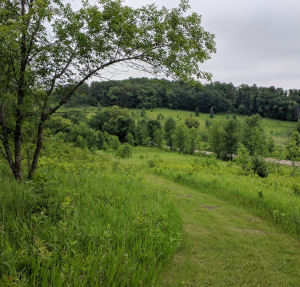
View from Skrall Hill. Car at center for perspective.
Whetstone
Mooring Stones
Anchor Stone
The Runestone
As we proceed east, we run into one of those items that has been debated for over a hundred years; the Kensington Runestone. It can proudly bear the title of being the most famous runestone in the world not only due to the amount of controversy it has borne since its discovery but in the amazing story it tells.
In 1898 a local farmer, Olof Ohman and his son were uprooting trees to clear land. Upon overturning an aspen (they referred to it as a poplar) of 8 to 10 inches in diameter they found a large, flat stone clutched in its roots. It was Ohman's son that actually pointed out the strange markings on it. A neighbor, Nils Flaten witnessed the upturning of this stone from a short distance away.
The trees roots were cut from the stone and it was taken back to the Ohman farm where the dirt was cleaned out of many of the runes with a nail. About a dozen local citzens signed affidfavits on viewing the stone and the tree roots.
Initial attempts to decipher the stone were not very successful. In fact, Ohman actually obtained a book of Norse runes and tried himself with help from his local pastor. The book was of turn of the millenia runes and thus made their decipherment very difficult as the runes on the stone were eventually determined to be fourteenth century.
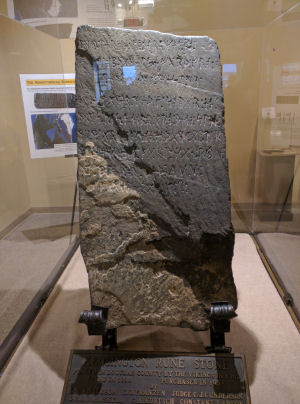
|
| The Kensington Runestone (front view) |
One of the foremost European experts of the time, upon viewing a drawing of the runes, immediately declared them to be a forgery and many of his associates (read cronies) declared the same. This set the spark igniting the debate on the genuinity of the stone for decades.
The stone ended up back at Ohman's farm where it rested for a number of years. In 1907 Hjalmar Holand was shown the stone and it was he who re-ignited the investigation. Holand obtained the stone for further display and research. He made some of the first accurate attempts to translate it. Over the years this translation has been modified and adjusted.
The runic lettering tells a story of an expedition that came to grief. The following is the generally accepted script:
***
8 Gotlanders and 22 Norwegians on a back taking (reclamation,exploration) journey west of Vinland.
We camped by 2 skerries (islands, shoals) one days journey north of this stone.
We were also fishing one day.
After we came home we found 10 men red with blood and dead.
Ave Maria. Save us from evil.
We have 10 men at the haven (harbor,camp) looking after our ship 14 days journey from this island (peninsula). Year 1362
***
A Committee was established by the Minnesota State Historical Society that examined the stone carefully. The mutual consensus was that it was genuine. Original examinations of the weathering of the stone placed its aging at 150 years plus.
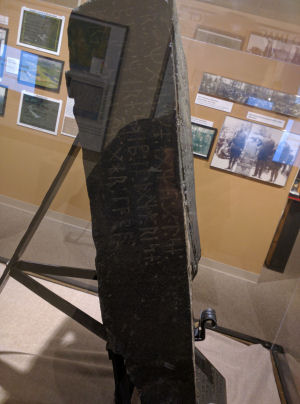
|
| The Kensington Runestone (side view) |
For decades public consensus has see-sawed back and forth with many experts and pseudo-experts offering their opinions. The stone has been displayed and examined by numerous groups and at many conferences world-wide since its' discovery.
It currently resides in the Runestone Museum, Alexandria, Minnesota. The site where the stone was found is at the Runestone County Park 15 miles southeast of the museum.
May 15
Kensington Runestone Part 2
OBJECTIONS
From the very early days the KRS has been subject to claims of forgery and hoax. We decided to examine these claims in great detail to determine what is the truth. My research took me through many books and websites including a visit to the Runestone Museum in Alexandria and a number of visits to the site itself. I found both to be maintained excellently and the museum is very open with the hoax theories including displays about them. They encourage one to approach with an open mind and makes ones own decisions about the stone.
In all my study I did not find one single objection to the stone that was valid. They all fell into either misinformation, malice or misrepresentation. Many of the early detractors of the stone were in direct competition with Holand and were probably provoked by an intense jealousy. Much of the evidence shows that they conspired to
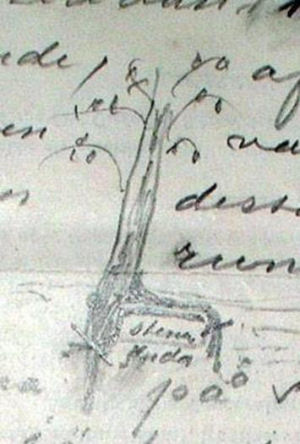
|
| Ohman's original diagram of the tree roots |
History has an amazing way of forgetting the wrong. Many theories can be applied to a situation but generally the ones that are incorrect are quickly forgotten. Only the correct theory is remembered as it then becomes the stepping stone to whatever is next. Wrong theories result in dead ends.
I have deliberately left out the names of the detractors in this blog as they can be disregarded. I have included those that are guilty of deliberate misinformation as well even though they genuinely deserve much harsher criticism than obscurity.
Here are the primary objections to the genuinity of the stone with an examination of the actual facts.
The European experts that originally proclaimed the stone a fake examined only paper tracings made by Ohman. They were unfamiliar with fourteenth century Norse runes or pendatic dating and subsequently were unable to decipher them. To them, this was enough cause to declare a fake. They refused to consult experts in medieval language and runes. (These will be examined later.)
The first claim of hoaxery pointed its finger at Ohman. They claimed he had carved the stone himself as a prank. Variations on this theme had his sons and neighbors helping him up to and including the local pastor. Nastier accusations as to his credibility were made against him when he denied these claims and because of this the family went through much undeserved criticism.
Throughout all this subjectivity Holand defended Ohman's reputation adamantly even though the two men had a falling out over the ownership of the stone. The photograph taken of Ohman and Holand sitting together at the Fahlins Point rally in 1927 exudes the obvious tension between the two. The rally was held to gain support for a monument.
Olaf Ohman's integrity was never questioned by the residents of Kensington who knew him. As a matter of fact, the local banker, a Mr. Engebretson, related a story that testifies to Ohman's veracity. One winter, in the middle of a blizzard, Ohman showed up at the bank after walking the three and one half miles from his farm. He was there to make a loan payment that was due on that day.
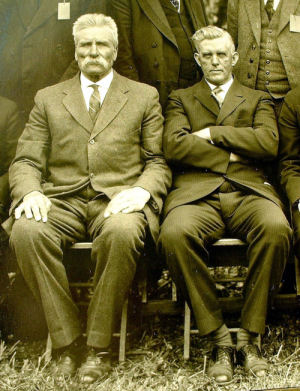
|
| Olaf Ohman and Hjalmar Holand 1927 |
Let us look at these one at a time.
There was no deathbed confession. At least, not by Ohman. According to Walter Gran, his father John Gran claimed he had helped Ohman carve the stone. The two were neighbors that did not get along. Walter Gran was known in the community to 'embellish' things. Another case was of Mr. A. Anderson admitting he helped Ohman carve the stone. This turned out to be a complete fabrication by a get rich quick author. Anderson was officially interviewed and vehemently denied ever saying anything of the sort. Another rumor said that Ohman told someone that he wanted to play a prank on all the experts by carving the stone. This one borders on ridiculousness as whoever carved the stone had to be very well educated in the language and runes of the fourteenth century. Ohman had six weeks of formal education.
Ohman buried the stone, planted a tree on it and later staged a discovery cannot be correct as Ohman emigrated in 1879. He bought this land in 1891. Conservative estimates of the age of the tree based on the size is 30 years and upwards. The tree was growing on that spot before Ohman arrived in America.
That the runes are fresh is incorrect. As mentioned previously, many of the runes had the dirt scratched out of them by Ohman. Fourteen of the runes were left untouched and were used in later scientific examinations.
Runic experts have determined the writer of the stone came from East Gotaland where Ohman came from Halsingland over 100 miles away. Their dialects were different.
That Ohman purchased a book on runes and traced them is correct but this was after he had discovered the stone, not before. He wanted to try to understand what he had found.
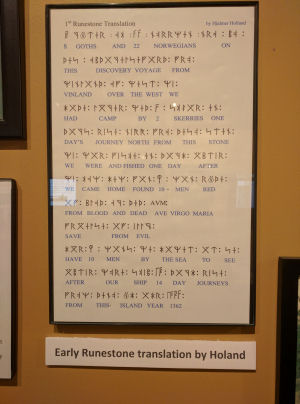
|
| Holand's translation of the stone |
So if he did not carve the stone, who did? It would have to be someone before 1868. In Minnesota, in 1868 there were few settlers due to hostile Sioux. Our carver had to be skilled in stonecarving, Norse runic language of the fourteenth century and well educated in runes not yet known to anyone else. This 'Johnny Appleseed' type character also planted numerous supplemental artifacts throughout the general area before 1870.
I think it is safe to conclude that if this were a court of law, every one of these objections would be over-ruled by the judge.
June 15
Kensington Runestone Part 3
TECHNICAL AND SCIENTIFIC FACTORS
The pro arguments for the genuinity of the KRS all had very sound technical and scientific basis. Runeologists have examined the stone for the linguistics of the runes and top geologists have done tests on it.
The stone itself is composed of greywacke with a calcite layer at the bottom. The stone weighs 202 pounds and is 31"x16"x5". The stone is of local origin.
Although Ohman had scratched the dirt out of most of the runes with a nail (there are 11 documented references to this) there were fourteen letters that were left untouched. These were examined microscopically and later with more modern tools such as 3d imaging and spectrographic analysis.
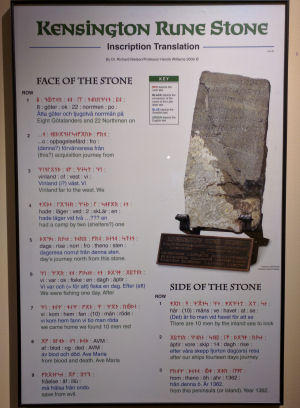
|
| Recent translation at the Runestone Museum |
Subsequent comparable studies have likened the wear on the KRS inscription to be similar to known old world stones in the 1325 to 1375 era. 3d imaging was also used to determine the age of letter deterioration. A comparable dating was the Swedish Gustav Miles inscription of 1355.
An interesting argument was recently brought up. As the stone was buried for x number of years, the calcite should deteriorate faster than the greywacke. If they were in the same state of deterioration, that would prove a recent age to the KRS. Under extremely high magnification it was shown that the calcite did indeed show more erosion than the greywacke.
In 1907 Holand carved his initial H on one side of the runestone. This brought up the claim that Holand had carved the stone and was subsequently signing it. Of course, Holand was not yet born when the stone was buried. Today, having been over 100 years, we can look at the rate of deterioration of this H under protected or ideal conditions.
THE TREE
An experimental archaeologist cut down an aspen tree of comparable size to the tree that Ohman pulled. He took a cross section of the tree and counted the rings. There were 38. This experiment was based on reasonable growth conditions. This would suggest the minimum date for the runestone tree at 1860.
RUNES AND LANGUAGE
There has been enough discussion on the runes and language of the KRS to bear looking at on its own.
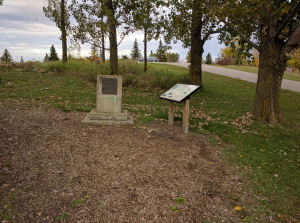
|
| Runestone discovery site |
The Mansta Yoke Inscription carved in 1907 was touted as evidence of the KRS being a fake. It was quickly found that this inscription was based on Ohman's early published tracing that contained several errors. Many runes had missing parts.
Another objection that was swiftly overturned was that of the Larsen Rune Rows, a set of papers tracing runic writing. Discovered in 2004, there were 2 copies made. One dated December 1883 and one dated April 1885. The papers contained 6 runes that experts said didn't exist and it was inferred that Ohman used the Larsen papers to carve the KRS. There were also earlier claims that Ohman had originally invented 7 runes but they were actually found to be on the Larsen papers. There were discrepancies however in the Larsen papers. Larsen had put down a zero for the pendatic 10 that was used on the KRS and numerous other stones. It is believed now that Larsen, a tailor, copied these runes from older documents he found. He had also copied on these papers box code used on a fifteenth century Cistercian manuscript.
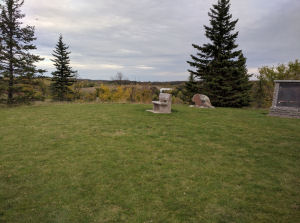
|
| Flaaten farm in the distance |
Arlington Mallery affirmed the validity of the KRS based on pendatic dating which was relatively unknown in 1898. The Kingittorsuaq runestone (GR 1), found in 1824 in northern Greenland, bears the same dating style.
The Easter table dating system confirms the 1362 pendatic date. This was a secret back-up dating system used by monks to confirm the written date. Exactly how it works I will leave to the experts to explain. It is obviously a correct system as it has been verified with dozens of examples. There is apparently also a secret message on the stone that states, 'Ivar composed me'.
It is generally agreed that the KRS was carved by 2 Cistercian Monks. Wolter infers that Templars and Teutonic Knights were present at the KRS site.
Here are some facts about some of the specific letters on the stone.
The Hooked X symbol. Wolter researched this letter and found multiple comparisons throughout north eastern Europe. He believes that this symbol is related to the
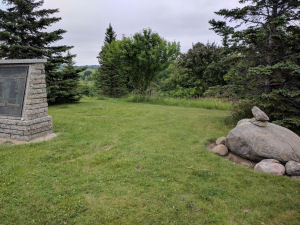
|
| Monument and mooring stone |
The Dotted R. This letter was unknown on other stones until 1935. Then the Ukna grave slab circa ad 1200 was discovered. The Lund find of 3 bones with inscriptions was in 1938. They were labeled G70, G192 and G282.
The Palatal R. This letter was originally thought obsolete by the late 1100s but has since been proved to still be in use in the 1300s.
The Crossed L. There is a direct comparison with the Codex Runicus of 1329 and the Mariaklagen documents of 1325.
GEOGRAPHY
The runestone mentions 'this island' but the KRS was found on a hill. An alternate translation for this word is peninsula. Nevertheless, a Hydrological report done in 1937 indicates flooding in the area. At the time of the carving of this stone, the hillock it was found on was indeed surrounded by water.
The KRS uses the term 'Dagh rise' which translates as days journey. This was a standard form of measurement equivalent to our 75 miles.
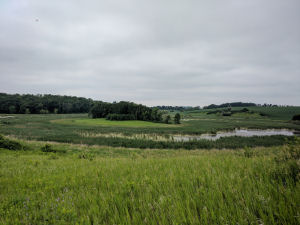
|
| Island where the AVM stone was found |
ADDITIONAL FACTORS
An archaeological dig by Christina Harrison in 1976 was inconclusive.
July 15
Kensington Runestone Part 4
I think it is a very obvious conclusion that the KRS is a legitimate fourteenth century artifact. There are too many factors in its favor. Also we must look at the large number of related artifacts that have been found in the Minnesota area since the original pioneers came through. So let us finally put to rest the pointless argument on the genuinity of the stone. We can now move forward to unravel more of the mystery of the Norse in North America.

|
| Olaf Ohman caricature on NFL team logo |
This same Swedish crew has secured permission to dig at the site where the KRS was found. They have apparently already used GPR (ground penetrating radar) there. They are also recording everything in a documentary.
This is not the only documentary that has featured the Kensington site recently. America's Lost Vikings is a six part series aired on the Science Channel that examined the Norse visitations to North America. They looked at LAM, Sop's Arm, New England and Kensington. Yours truly makes a brief appearance in episode 2 at Sop's Arm.
In regards to GPR, on one of my visits to the KRS site I got to experience a different sort of related exploration. Dowsing (known locally as witching) has been used for centuries to locate water. More sophisticated forms of dowsing are used to locate other items. I learned that a series of dowsings by a few individuals at the runestone site resulted in details of burials, buildings and a ship.
Some people scoff at dowsing while others defend it fully. The method has been used with some measure of success in water divining for generations so there must be some merit to it. But can it provide details to us of what is at the runestone site? The use of GPR will certainly answer this one. I anxiously await the results.
Since the KRS is legitimate we can use this historical artifact as a Rosetta stone in the advancement of the field of fourteenth century runeology. As a verified runestone it can teach us what to look at and for on future discoveries. It will also help to elucidate past ones. Our prime example is the Spirit Pond runestones which will be examined in their due course.
A mid fourteenth century Norse expedition came to grief in the Minnesota area. Two of the critical five questions (how, why, when, what and where) have been answered
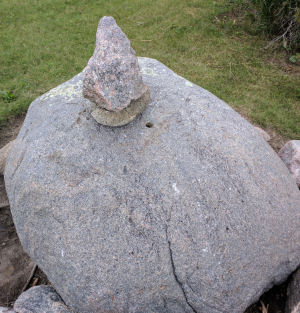
|
| Mooring stone on runestone hill |
August 15
More items at Kensington
My apologies for the delay in getting the blog out this month. I have just returned from a trip to Minnesota and Iowa in search of more Norse presence.
Whetstone
There was a very worn whetstone found buried six inches underneath the runestone. When thrown on the ground by Ohman it broke. It was found to have a metal core.
This layer of earth indicates that the whetstone had soil accumulation on it before the runestone fell over.
Interestingly, Peter Kalm, an eighteenth century Swedish scientist that visited North America, reported about a great earthquake that took place in February of 1663. It was felt at Quebec and a great part of Canada. This is known as the Charlevoix earthquake.
Could this earthquake have extended as far west as Kensington? Could it have toppled the runestone on to the whetstone? Could it have been another earthquake? There was a massive earthquake on the west coast in 1700.
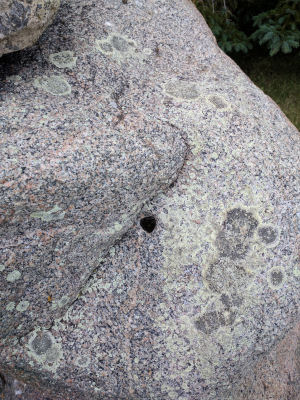
|
| Close up of mooring stone on runestone hill |
If one looks at a Google map of Minnesota, one can see the numerous lakes that dot the state. These are the remnants of Lake Aggasiz, an ancient sea that covered a good portion of the plains. Perhaps by using a reverse 'drain the oceans' technology we could then determine where the shorelines were in 1362.
******
Mooring Stones
A map of the runestone site shows fourteen mooring stones not counting the one previously documented on Skrall hill. The first stone was documented by Hjalmar Holand during his own research. Five more were found here by the Johnson/Westin group in 2001.
Scott Wolter is of the opinion that the KRS was deliberately buried and that the geometric pattern of the mooring stones shows its location at the center.
Interestingly, there are over 125 mooring stones within an 80 mile radius of the site. Theories that they are land claim markers are quite predominant as are those of secret geographic markers.
******
AVM Stone
A short distance from the KRS another stone was found. Also of greywacke it had AVM carved into it. Initial excitement turned into dismay when it was later found to have been produced by some university students in the 1980s in an attempt to recreate runes.
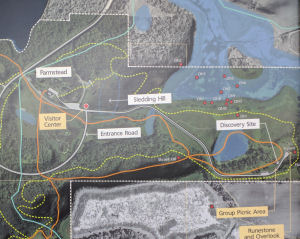
|
| Visitors Center map showing mooring stones |
******
Anchor Stone
In the Kensingston town hall there is an unusual stone displayed. It was found at the runestone site. The stone displays a central area that is hollowed out and is ideal for a rope to be tied around, subsequently making it useful as an anchor.
Whether this grooved area is man made or an act of nature is yet to be determined.
September 15
The latest from Kensington
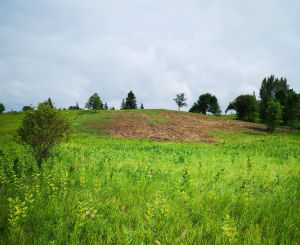
|
| West side of Runestone hill showing dig site |
While at the runestone site I attempted to locate the mooring stones that were clustered at the base of the hill. (see map) On a blistering hot and humid day with much struggling and trudging through thick undergrowth, brambles, thorns, wild rose bushes and angry bees I found three of them. They were quite overgrown and have not been disturbed for some time. The holes are correct. They were hand chiseled in proper shape and depth. Near by brush had been cleared in a strip and I expect GPR was used in this area by the archaeological crew.
The cluster of mooring stones on the map are a bit of a puzzlement. Much of that area is low and marshy. With the belief that these areas should have been under water in 1362, these stones would be submerged. Interestingly, there are many other examples of submerged mooring stones in other areas. This, combined with the presence of mooring stones on hilltops or dry ground well away from water is a mystery yet to be solved.
While at the Runestone museum I was able to closely examine several of the artifacts including the whetstone mentioned above. It was verified that there is a metal core to the whetstone. I was also able to view the core sample
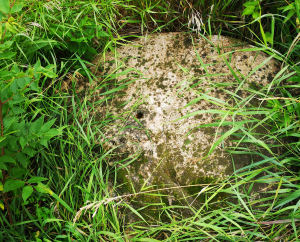
|
| One of three stones found in lowland |
Here are some websites with further information on the KRS. One can Google many sites that refer to the KRS on the internet nowadays, both pro and con. It is encouraged that the modern day scholar examine all the documentation available, both for and against. The researcher should make his or her own decision on the genuinity of the stone.
thevintagenews.com/kensington-rune-stone-decoded-vikings-templars-and-goths-in-america-in-1362/2/
http://www.kensingtonrunestone.us/
Geographical location: 45.810, -95.661
October 15
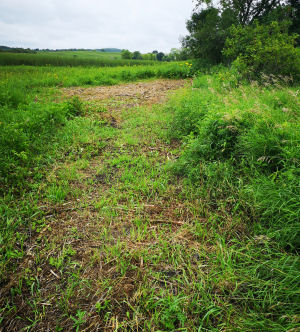
|
| The lowland area cleared of brush. I found three mooring stones near the trees in the distance |
We can now turn back to the old world for some documented evidence about the presence of the Norse in North America.
The KRS gives us proof that the Norse were in Minnesota. We can hence ask the questions: Did they only explore or did they attempt to settle in this area? Was there only one visitation or multiple? How or why did they come to be here?
The answer begins in 1342 when the cleric Ivar Bardarson paid a visit to the Western Settlement of Greenland. He found it abandoned with feral horses and cattle running loose. There were no signs of violence or pestilence. His reports were supplementarily documented by one Bishop Oddson. In 1637 the bishop mentioned in his annals that about 1342 "the inhabitants of Greenland voluntarily left the Christian faith and turned to the American people."
We have evidence that when King Magnus learned of the missing Greenlanders he appointed one Paul Knudsen to find out what happened to them. Knudsen was the Law Speaker for the Bergen Gulathing. There is nothing further known or heard about Knudsen after this letter.
This is the most accurate translation of the document that I could find:
*****
King Magni letteer of command given to Powell Knutsson at Anarm to sail to Greenland.
Magnus, by the Grace of God, King of Norway, Sweden, and Skone, sends to all men who
see or hear this letter good health and happiness in God.
We desire to make known to you that you are to take all the men who shall go in the
knorr whether thy be named or not named, from my bodyguard or other men's attendants
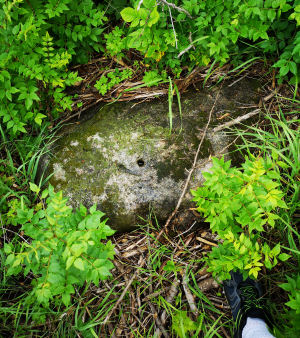
A second mooring stone
or of other men whom you may induce to go withy your, and that Powell Knutsson, whi is
to be commandant on the knorr, shall have full authority to name the men whom he
thinks are best, both as officers and men. We ask that you accept this our command
with a right good will for the cause, as we do it for the honor of God and for the
sake of our soul and our predecessors, who have introduced Christianity in Greenland
and maintained it to this day, and we will not let it perish in our days. Let it be
known that whoever breaks this our command shall feel our displeasure and pay us in
full for the offense.
Executed in Bergen on the Monday after Simoni and Judae Day in the 36th year of our
rule Herr Ormer Ostinsson, our Lord High Constable, set the seal. Oct. 28, 1354
*****
Obviously Knudsen was commissioned to go to Greenland to find out what happened to the missing Greenlanders. He is given quite a bit of latitude on his mission with specific instructions noticeably lacking. In effect, he has been pretty well awarded a 'letter of marque' much as Queen Elizabeth I gave to Francis Drake. Not unusual for the times.Conversely, the King has however specified that men be taken from his bodyguard and personal attendants for this venture. Not only would this validate the officiality of Knudsen but also assure that the purpose of the mission was adhered to. Other than this, Knudsen is given full command of the ship 'The Knorr'and open discretion on what is to be done.
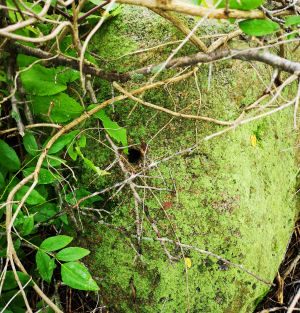
|
| Third mooring stone |
Although the apparent motive of the expedition is to restore religion; Knudsen is a lawspeaker, not a cleric. If this was to be exclusively a religious mission the King would have given it to a bishop or the likes. There are other factors to be considered.
In 1352 the Pope grants King Magnus half tithes for the next 4 years to help pay for his crusade in the east. An expedition to find missing parishioners would not only collect tithes but back tithes. Additionally, in 1369 Philippe De Mezieres notes that 'the Kingdom of Norway was so vast with lands so far that it took tax collectors three years to go there and get back.'
Perhaps like many expeditions, this one had multi purpose. The possibility of this expedition belonging to part of a fleet is discussed later when we look at the Newport Tower.
One has to consider the nature of the 'Vikings' in the Knudsen Expedition. Although these men were descendants of Vikings, they were not really Vikings. By this time in history, they have been Christianized for three hundred years. This expedition, rather that being comprised of battle hardened warriors, were more than likely also comprised of a more bureaucratic group. Taxmen, diplomats, priests and merchant traders or the likes. There would only have been a spice of the military or king's bodyguards (as specified in Knudsen's charter from the King). That this group included Templars and Teutonic knights is not inconceivable.
So what happened to them?
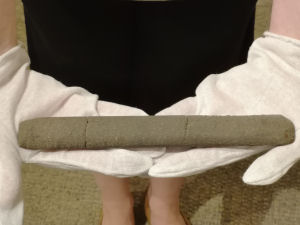
|
| Whetstone at the Runestone Museum |
November 15
The Return
Paul Knudsen is never mentioned after the letter of marque. Nor is he mentioned on the Kensington Runestone or the Spirit Pond Runestone. It is possible Knudsen was never on the expedition. Perhaps he died of the plague and somebody else took his place.
Regardless, the letter of marque corroborates the KRS. If Knudsen wasn't the leader of the expedition, then certainly somebody else was. It is nevertheless an indication that someone went looking for the missing Greenlanders. Perhaps there was more than one letter of marque given out and there were several expeditions.
A document released by the British Museum in 1955 adds another piece to the puzzle. One Jacob Cnoyen is reporting to Mercator about interviewing some individuals in 1364 in Bergen, Norway.
Here is the translation:
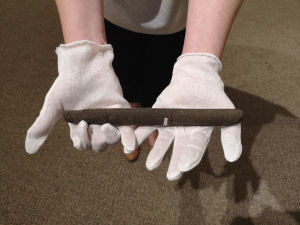
|
| Reverse side of whetstone |
Nearly 4000 persons entered the indrawing seas who never returned. But in A.D.1364
eight of these people came to the King's Court in Norway. Among them were two
priests, one of whom had an astrolabe, who was descended in the 5th generation from
a Brussels citizen. One, I say: all eight were from those who had penetrated the
northern regions in the first ships.
Leaving the rest of the party who had come to the Islands, he journeyed further,
through the whole of the North etc, and put into writing all the wonders of those
Islands, and gave the King of England this book, which he called in Latin 'Inventio
Fortunatae.'
*****
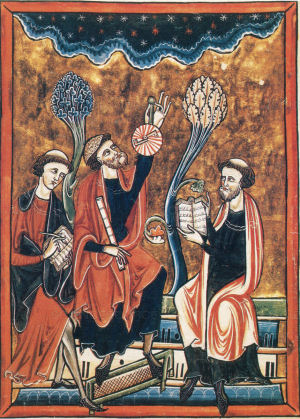
|
| Medieval illustration of Astrolabe use |
It is believed he accompanied an expedition to Vinland. The expedition separated and Nicholas went with a group to the far north. He brought back the first descriptions of the magnetic pole as well as making sketches of Hudson Bay and the north. It is believed his chart of Hudson Bay was made in 1362-63 and copied by such notables as Behaim (1492) and Ruysch (1508). This was also the source for the Gemma Frisius Globe of 1537.
Interestingly, Henry Hudson explored the bay that holds his name in 1610.
With this additional information we can now ask some questions and look at some other alternatives.
December 15
Ivar was here
Theories and Alternatives
What can be found at the KRS site
******
Ivar was here
Could Ivar Bardarson have been on the Kensington expedition? If we look at what can be found on the KRS, examine a biography of Ivar and then add in the documents from the Knudsen expedition as a final factor we come up with an interesting possibility.
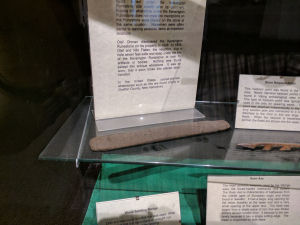
|
| Whetstone on display at Alexandria |
The stone was carved by two Cistercian monks
The language was in a Bohuslan (Sweden) dialect
Easter Table dating verifies the 1362 date
A secret message on the stone reads 'Ivar composed me'
A ship is at a haven/harbor 14 daghrise (1050 miles) from the runestone sight which approximates in distance to Hudson Bay
*Traditionally a runestone should have a makers mark or identifier on it. Secret marks are not unknown on many other stones and is illustrated here by the Easter Table Dating. The significance of the ship comes to play later.
We want to learn more about Ivar. The Norwegian Biographical Lexicon tells us about our cleric:
His birth date and place unknown

|
| Unusual stone found at runestone site |
1342 Visits the Western Settlement
1349 Appointed Head of Greenland Diocese
1364 June 25 - Canon at Apostle Church, Bergen
*Ivar Bardarson's book: Description of the Old Greenland 1930 (Danish translation) is apparently an accurate rendition of his earlier manuscript of which no copies exist. Anybody have this document hanging around by chance?
Now we tie in the Knudsen documents:
1354 Knudsen appointed leader of an expedition
1364 Eight men return to Bergen from an expedition to Hudson Bay. 2 are clerics
*Knudsen would have most certainly contacted Ivar to interview him about the missing Greenlanders and in fact even invited or commanded him to come along. Let's face it, after ten plus years of administering the Greenland Diocese the chance of joining a squadron of ships seeking lost souls would be irresistible, especially considering a fellow cleric with an astrolabe has come along. We know that Nicholas of Lynn was one of the returnees. Perhaps Ivar was the other cleric. Becoming a Canon at a major church in Bergen would be a just reward for a job well done.
Many epigraphers are adopting a confidence rating scale for their inscriptions. On a scale to 100, 0 to 10 is highly unlikely, 10 to 50 is possible, 50 to 90 is probable and 90 to 100 is nearly certain. With the above information, Ivar scores a 75.
It will remain for future researchers to locate any additional documentation that will either raise Ivar's score or put it to zero.
*****
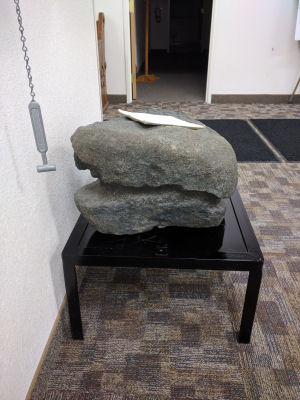
|
| Back view of anchor stone |
There are numerous different theories being looked at by scholars that pertain to the KRS and the Runestone site. Most generally agree that '10 men red with blood and dead' refers to a massacre by hostile natives. Some claim this could mean they died of the bubonic plague and there are even those that think this was an internal fight among the men themselves or with allies. Perhaps these ten men were not related to the expedition at all but were strangers.
Differing interpretations of the runestone can bring up alternate scenarios. Most KRS scholars are of the opinion that a massacre took place one daghrise north of the runestone site. Holand pinpointed this site at Cormorant Lake as it is 75 miles from Kensington. It is believed the survivors then fled to the runestone hill where the stone was carved.
This brings up an interesting thought. Instead of pursuing the killers of their comrades in a vendetta, which the Vikings of an earlier age would have done without a second thought, this group chose rather to flee, possibly in terror. Perhaps the gentlemen and clerics were fishing while the warriors, servants and bodyguards stayed in camp. Protect us from evil!
An alternate viewpoint has this expedition set up at the runestone site as a booth or semi permanent location. A group of the explorers went fishing and camped a day away from their main base. When they returned 'home' (the runestone site) they found the massacred men. This would place the massacre site at runestone hill, where the stone was carved and the expedition obviously spent some time.
Perhaps we might consider this site was a gathering place (althing) for the people that our expedition was seeking. In the typical Greenland/Iceland Norse colonizing methods the homesteads would have been scattered over a wide area. Water and land are plentiful in this area and it would be ideal for settlement.
Maybe a tax gathering expedition encountered a pagan Norse settlement which had been blended with the local population for five or more generations. Upon having demanded tithes of the missing Greenlanders, a dispute might have ensued.
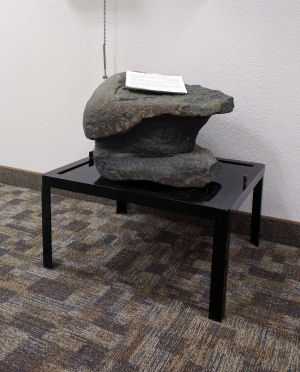
|
| Front view of anchor stone |
What can be found at the KRS site?
The absence of hard artifacts at the site would indicate the lack of settlement which is not surprising for a Greenland Norse populace. Notwithstanding, the KRS and the plentitude of mooring stones does indicate some importance to this location.
It is probable the graves of the ten dead men are here. Three possibilities exist. They died and were buried here, they died and were buried elsewhere or they died elsewhere and were buried here.
A fourth option of died here and buried elsewhere is unlikely. If the expedition took the time to carve the stone, they would have had time to bury these men. Explorers traveling great distances would not have taken their dead with them.
There are more possibilities of things to be found at the site:
Another runestone or more than one
More mooring stones
Boat nails, planks or remnants
Building foundations, construction materials,residue
Campsite remains, fire pits, animal bones, residue
Refuse pit
Other graves
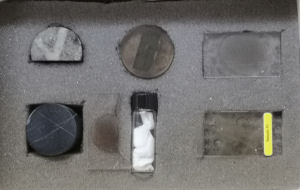
|
| Runestone samples used in scientific testing |
....to be continued.